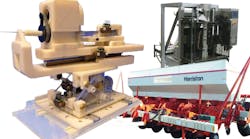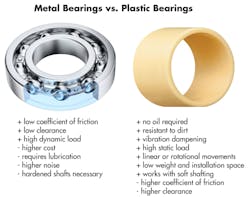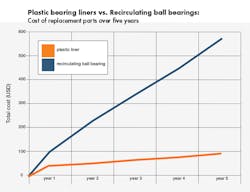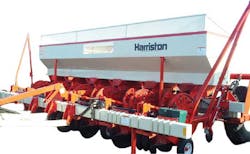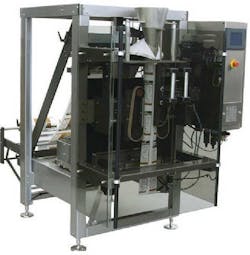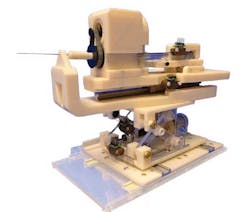The Best Bearing Lubrication System May be None at All
Machine and equipment manufacturers are feeling more pressure than ever to cut costs without sacrificing machine performance, a balance that can be difficult to achieve. OEMs often overlook a simple way to get a long-term improvement in profitability for themselves and their customers: eliminating bearing lubricants. By getting rid of lubrication subsystems, OEMs reduce production costs while making their equipment more marketable and less expensive to operate. At the same time, the costs and hassles of properly disposing of used oil can be eliminated, plus the initial expenditure for ancillary processes and components such as grease lines, fittings and manifolds can be lowered or eliminated.
So, what are the problems with bearing lubricants? According to a major ball-bearing company, 54% of bearing failures are lubrication-related. And an MIT study estimated that about $240 billion is lost each year in the U.S. due to downtime and repairs on manufacturing equipment damaged by poor lubrication.
There is a lower-cost, easier-to-maintain component that eliminates the total cost of bearing lubricants: high-performance, dry-running plastic bearings.
The Hidden Costs of Lubrication
Proper lubrication delivery is critical for ball bearings. Most require continued maintenance for relubrication, which typically requires scheduled downtime. This increases maintenance costs and causes a loss of production time.
Although some relubrication processes are automated, most are performed manually using a grease gun. It takes a series of critical steps to ensure proper lubrication, including carefully storing and handling the lubricant, properly cleaning the bearing, and using the right amount of lubricant and the right grease gun, to name just a few. In addition, it is critical to use the same grease for the bearing’s entire lifespan.
A major oil company studied the time it took to manually lubricate a single grease point. It indicated that manual lubrication takes an average of three minutes per point. The average machine has 20 grease points to maintain, which correlates to a total annual labor cost of $7,300 for one machine.
Another source claims that the average plant employs 2,196 bearings and spends $60,000 on relubrication annually; of that, $57,000 is just for labor.
Lubricated bearings can increase manufacturing complexity and expenses. They often need to be fitted with grease fitting (zerks) and manifolds, oil lines, and sometimes oil reservoirs and pumps. Not only are there costs for buying these components, there are also manufacturing costs for machining and assembling the mating parts.
There are also parts needed to protect bearings from contaminants. The leading cause of bearing failure stems from lubrication contaminated by moisture and solid particles. If as little as 0.002% water gets mixed into the lubricant, the probability of failure jumps by 48%. And just 6% water can reduce the bearing lifetime by 83%.
Ball bearings need seals to keep oil in and unwanted water and liquids out, as well as wipers and scrapers to keep out dust and debris. Seals only last so long and do not perform well in dirty and dusty environments. And they also increase friction. In agricultural machinery and lawnmowers, where dust and debris are prevalent during operation, seals and wipers must often be replaced.
Improper bearing lubrication or relubrication also accounts for up to 50% of machine failures. When a bearing fails prematurely, several steps may need to be taken. Replacing the bearings, shafting, and even motor or other parts can be very costly. If the machine needs to be taken offline, expenses can potentially skyrocket. In a six-sigma manufacturing guide, it was estimated that the average cost for downtime is $500 per hour, and in some automotive and other high-volume production factories, downtime costs are considerably higher. In addition, unplanned downtime can ripple through the plant’s production schedule.
Getting rid of used lubricants can add up to approximately 20% of the lubricant’s annual cost, says Valin. This means if a plant spends $50,000 per year on lubricants, it will spend about $10,000 on disposal. In addition, the price of oil can affect costs as lubricants are normally petroleum-based, so when the price of petroleum goes up, so too does the price of lubricants.
Sidestepping Lubrication Subsystems
One surefire way to eliminate lubrication costs and headaches is to use self-lubricating plastic bearings. They are made of high-performance polymers and, unlike rolling-element bearings, they slide instead of roll. They consist of a base polymer embedded with fiber reinforcements and solid lubricants.
The fiber reinforcements increase load carrying capabilities and wear-resistance. At the same time, the solid lubricants get transferred from the bearing to the shaft to form a low-friction micro-finish which reduces friction. Unlike PTFE-lined bearings, plastic bearings’ self-lubricating properties are present over the full thickness of the bearing.
They also do not need external oil or grease and operate completely dry. Their lack of oil and grease makes them good candidates for food and medical processing, packaging and other sanitary applications. It also means they don’t attract dirt, eliminating the risk of seizing and the need for seals or wipers leads.
They are ideal for labs and food processing machinery that require a clean, oil-free operation. Plastic bearings also perform well in dirty environments like agricultural workplaces because they don’t attract and retain dust and dirt.
They work on softer shafts, even those made of anodized aluminum, which has excellent corrosion resistance and is usually less expensive and easier to machine than case-hardened materials and stainless steels.
Self-lubricating plastic bearings can reduce maintenance costs and unplanned downtime due to bearing failures. If a self-lubricated bearing needs replacement, the replacement part (a small, inexpensive plastic sleeve) can be purchased for a fraction of the cost of a recirculating ball bearing. And once installed, they don’t require maintenance, unlike traditional ball and metal-backed bearings.
Plastic bearing materials resist a range of corrosive media, including water, chemicals, cleaning products, UV rays and more. Specialized materials are also on the market that stand up to harsher media, such as hydrochloric acid, steam/autoclaving and radiation. This lets them be used in wash-down and even underwater applications.
Plastic bearings are good for short-stroke applications, unlike linear ball bearings, which require a long stroke to fully lubricate; short strokes can cause ball bearings to slide instead of roll over the shaft, causing damage.
Plastic bearings weigh about 80% less than metal ones. Cutting weight lowers drive requirements and can lower operating costs, reduce fuel consumption and lower the inertia of moving parts.
There are applications plastic bearings cannot handle. These include those with:
- High loads with high speeds: They lead to excessive frictional heat buildup and wear.
- Highly cantilevered loads: Plastic bearings slide, unlike ball bearings that roll, so linear applications with higher coefficients of friction may result in uneven movements for highly cantilevered loads or drive forces.
- Extremely precise applications: Plastic bearings have a higher running clearance than ball bearings, sometimes 0.001 to 0.002 in.
- Extreme temperatures: Plastic bearings are not recommended for applications with long-term temperatures exceeding 484°F.
From the initial purchase through the life of a bearing, plastic bearings eliminate the need for lubricants and the accompanying maintenance and protective components.
Matt Mowry is product manager for drylin linear bearings at igus Inc.
